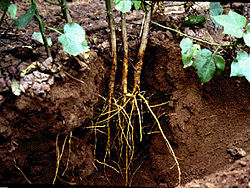Root pressure
The pressure that builds up in the root tissue of plants through osmosis is called root pressure. Together with the perspiration suction created by the evaporation on the leaves, this creates the water transport in the plant.
root cause
The transfer cells of the xylem parenchyma, that is cells in the wooden part, transfer osmotically active substances (especially inorganic ions ) into the conductive elements of the wooden part ( xylem ) through a secondary active transport . This lowers the osmotic potential there (the osmotic pressure increases), which results in an influx of water. The water from the root surface follows the osmotic potential gradient in the plant tissue to the inner endodermis , where the Caspary strips prevent direct advancement. Here at the latest and at the earliest at the cells of the root surface, the water must flow into the symplasts . After crossing the endodermis tissue, the water in the symplast flows on to the conductive xylem vessels. In these areas a hydrostatic pressure , namely the root pressure, builds up due to the inflowing water .
